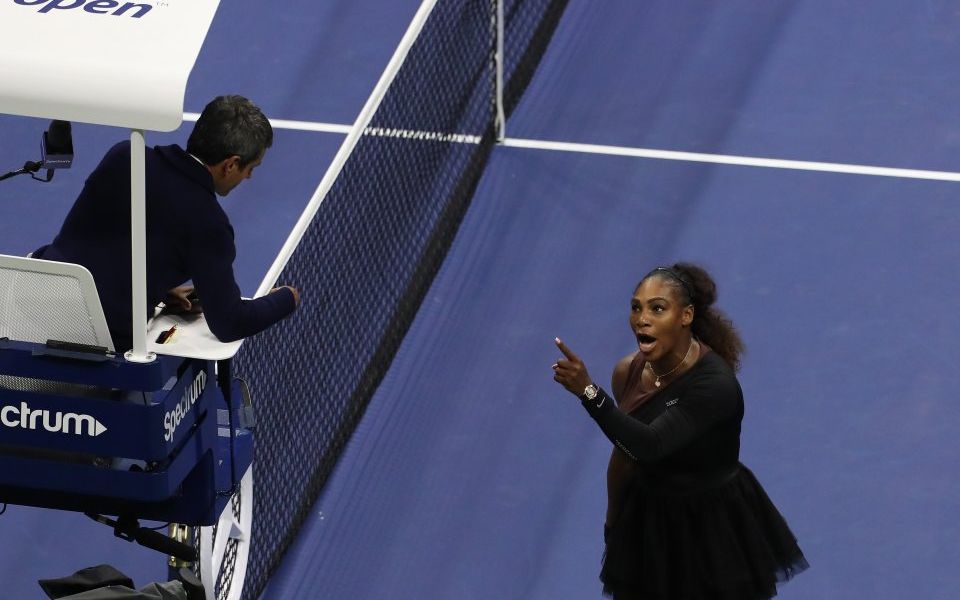Is it time tennis allowed on-court coaching?

Serena Williams’s now-infamous exchange with umpire Carlos Ramos during her US Open final defeat to Naomi Osaka earlier this month provoked extensive debate across the media landscape about sexism, gender roles and perceived double standards in sports officiating.
It also revived debate over the issue of in-game coaching. Williams was penalised for three code violations during the final, the first of which came when her coach Patrick Mouratoglou gestured from the crowd for her to attack the net more.
In a series of tweets after the match defending Williams’s claims of gender inequality, tennis legend Billie-Jean King also called for the grand slam tournaments to lift their ban on coaching.
“Coaching on every point should be allowed in tennis. It isn’t, and as a result, a player was penalized for the actions of her coach. This should not happen,” she said.
King’s remarks highlighted a split within the sport that is reflected in the contrasting attitudes of tennis’s multiple governing bodies.

Naomi Osaka won her maiden grand slam at Flushing Meadows this year, thrashing Serena Williams 6-2 6-4 in the final (Source: Getty)
Far from prohibiting it like the men’s tour and grand slams, the Women’s Tennis Association (WTA) permits coaches to speak to players during changeovers. More than that, the WTA has made it a feature of its tournaments, with court-side microphones picking up the coaching instructions for viewers’ consumption.
“The fact is there is coaching. They all have coaches, and that has been the question for years: are they coaching from the box or aren’t they?” said WTA chief executive Steve Simon in 2017. “I think coaching is something the sport needs to embrace – it’s part of the story.”
Read more: Amazon's US Open coverage represents a missed opportunity for streaming
That viewpoint was underlined in the WTA’s response to the US Open final, in which Simon reiterated calls to bring coaching into the men’s game and the four grand slams.
“We think the issue of coaching needs to be addressed and should be allowed across the sport. The WTA supports coaching through its on-court coaching rule, but further review is needed,” said Simon.
Traditionally, singles tennis has been seen as a contest between two players, a psychological battle where coaching is regarded as cheating. This includes any form of communication to the player on court from their team in the crowd, such as hand signals and spoken words, even if the player doesn’t see their team do it.
This is a standpoint adopted by the International Tennis Federation (ITF), which presides over the four grand slams, and the Association of Tennis Professionals (ATP), which represents the men’s tour.

The US Open does not permit coaching to take place during a game except in the qualifying rounds (Source: Getty)
However, there are indications that attitudes towards coaching may be shifting. The US Open, for instance, has permitted coaching during the qualifying rounds of the grand slam since last year.
In an era of mass televised sport, it is increasingly clear that nearly everybody cheats. Gestures from a player’s coaching team to the athlete on court are commonplace and umpires can be inconsistent in enforcing code violations. It might make sense, then, to simply permit it to happen openly rather than allow anyone to feel aggrieved at an inconsistent application of the rules.
Top-level players spend millions on expensively assembled coaching teams whose job it is to strategise and build a game-plan with their player, particularly now in an era of super-coaches where icons such as Boris Becker, Ivan Lendl and Lindsay Davenport have come back to the game to support grand slam hopefuls.
It seems arbitrary to some players to make a distinction between coaching for hundreds of hours outside of the match but stringent rules during the contest itself.

Tennis has recently seen the rise of "super-coaches", ex-players who return to the game to help grand slam contenders (Source: Getty)
“When the WTA introduced on-court coaching, many ATP players were not really positive about it. I thought it was a good move for the sport,” said 14-time grand slam winner Novak Djokovic.
“We’re probably one of the only global sports that doesn’t use coaching during the play. Even golf – individual sport – you have caddies that you communicate with throughout the entire course.”
At last year’s US Open Rafael Nadal also supported the idea of coaching being permitted in the men’s game.
“It’s a little bit stupid that you have a coach travelling for you, with you during the whole season and practising with you every day, and in the most important moment he cannot tell you anything. In my opinion, it will be good if if the coach can talk,” said the 17-time grand slam winner.
Read more: Murray targets psychological edge after reuniting with Lendl
Nevertheless it isn’t obvious that the rules will change at any of the four Majors in the immediate future.
“While numerous discussions have been had relating to coaching in recent years, there has not been a consensus on the men’s tour to move away from the current practice which places emphasis on one of tennis’ key attributes as a one-on-one gladiatorial sport,” an ATP spokesperson told City A.M. “We do not expect that to change on the ATP World Tour in 2019.”
The future of coaching in tennis might be uncertain, however what is clear is the conversation is likely to rumble on for years to come.